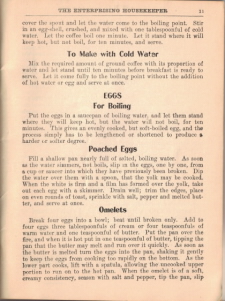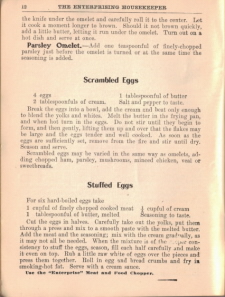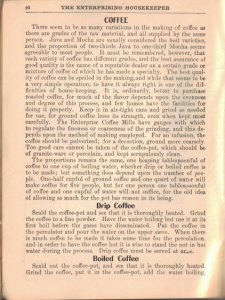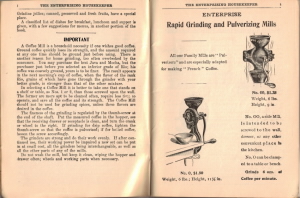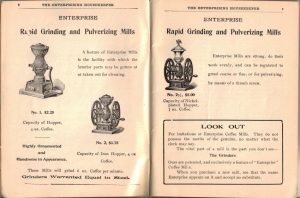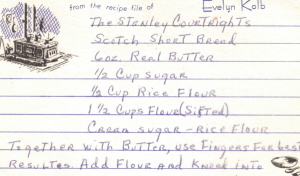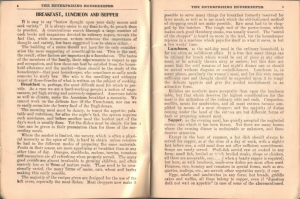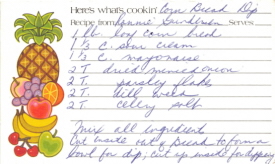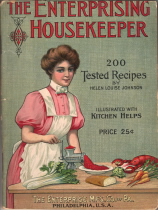 Here are pages 11 and 12 of the vintage booklet The Enterprising Housekeeper from the sixth edition (1906). If you’d like to follow along and browse through more pages of the book, I’m filing them in the Enterprising Housekeeper Category.
Here are pages 11 and 12 of the vintage booklet The Enterprising Housekeeper from the sixth edition (1906). If you’d like to follow along and browse through more pages of the book, I’m filing them in the Enterprising Housekeeper Category.
Eggs
For Boiling
Put the eggs in a saucepan of boiling water and let them stand where they will keep hot, but the water will not boil, for ten minutes. This gives an evenly cooked, but soft-boiled egg, and the process simply has to be lengthened or shortened to produce a harder or softer degree.
Poached Eggs
Fill a shallow pan nearly full of salted, boiling water. As soon as the water simmers, not boils, slip in the eggs, one by one, from a cup or saucer into which they have previously been broken. Dip the water over them with a spoon, that the yolk may be cooked. When the white is firm and a film has formed over the yolk, take out each egg with a skimmer. Drain well; trim the edges, place on even rounds of toast, sprinkle with salt, pepper and melted butter, and serve at once.
Omelets
Break four eggs into a bowl; beat until broken only. Add to four eggs three tablespoonfuls of cream or four teaspoonfuls of warm water and one teaspoonful of butter. Put the pan over the fire, and when it is hot put in one teaspoonful of butter, tipping the pan that the butter may melt and run over it quickly. As soon as the butter is melted turn the eggs into the pan, shaking it gently to keep the eggs from cooking too rapidly on the bottom. As the lower part cooks, lift with a spatula, allowing the uncooked upper portion to run on to the hot pan. When the omelet is of a soft, creamy consistency, season with salt and pepper, tip the pan, slip the knife under the omelet and carefully roll it to the center. Let it cook a moment longer to brown. Should it not brown quickly, add a little butter, letting it run under the omelet. Turn out on a hot dish and serve at once.
Parsley Omelet.–Add one teaspoonful of finely-chopped parsley just before the omelet is turned or at the same time the seasoning is added.
Scrambled Eggs
4 eggs
2 tablespoonfuls of cream
1 tablespoonful of butter
Salt and pepper to taste.
Break the eggs into a bowl, add the cream and beat only enough to blend the yolks and whites. Melt the butter in the frying pan, and when hot turn in the eggs. Do not stir until they begin to form, and then gently, lifting them up and over that the flakes may be large and the eggs tender and well cooked. As soon as the eggs are sufficiently set, remove from the fire and stir until dry. Season and serve.
Scrambled eggs may be varied in the same way as omelets, adding chopped ham, parsley, mushrooms, minced chicken, veal or sweetbreads.
Stuffed Eggs
For six hard-boiled eggs take
1 cupful of finely chopped cooked meat
1/4 cupful of cream
1 tablespoonful of butter, melted
Seasoning to taste.
Cut the eggs in halves. Carefully take out the yolks, put them through a press and mix to a smooth paste with the melted butter. Add the meat and the seasoning; mix with the cream gradually, as it may not all be needed. When the mixture is of the proper consistency to stuff the eggs, season, fill each half carefully and make it even on top. Rub a little raw white of eggs over the pieces and press them together. Roll in egg and bread crumbs and fry in smoking-hot fat. Serve with a cream sauce.
Use the “Enterprise” Meat and Food Chopper.
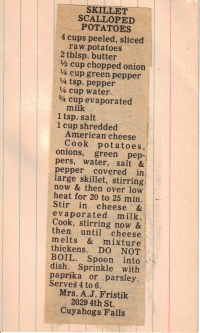 Here’s a recipe clipping glued to an index card, found in a box of old recipes.
Here’s a recipe clipping glued to an index card, found in a box of old recipes.
Skillet Scalloped Potatoes
4 cups peeled, sliced raw potatoes
2 tblsp. butter
1/2 cup chopped onion
1/4 cup green pepper
1/4 tsp. pepper
1/4 cup water
3/4 cup evaporated milk
1 tsp. salt
1 cup shredded American cheese
Cook potatoes, onions, green peppers, water, salt & pepper covered in large skillet, stirring now & then over low heat for 20 to 25 min.
Stir in cheese & evaporated milk. Cook, stirring now & then until cheese melts & mixture thickens. DO NOT BOIL. Spoon into dish. Sprinkle with paprika or parsley. Serves 4 to 6.
 Here is page 10 and part of page 11 from the vintage booklet The Enterprising Housekeeper, sixth edition (1906). If you’d like to follow along and browse through more pages of the book, I’m filing them in the Enterprising Housekeeper Category.
Here is page 10 and part of page 11 from the vintage booklet The Enterprising Housekeeper, sixth edition (1906). If you’d like to follow along and browse through more pages of the book, I’m filing them in the Enterprising Housekeeper Category.
Coffee
There seem to be as many variations in the making of coffee as there are grades of the raw material, and all supplied by the same person. Java and Mocha are usually considered the best varieties, and the proportion of two-thirds Java to one-third Mocha seems agreeable to most people. It must be remembered, however, that each variety of coffee has different grades, and the best assurance of good quality is the name of a reputable dealer on a certain grade or mixture of coffee of which he has made a specialty. The best quality of coffee can be spoiled in the making, and while that seems to be a very simple operation, to have it always right is one of the difficulties of house-keeping. It is, ordinarily, better to purchase roasted coffee, for much of the flavor depends upon the evenness and degree of this process, and few homes have the facilities for doing it properly. Keep it in air-tight cans and grind as needed for use, for ground coffee loses its strength, even when kept most carefully. The Enterprise Coffee Mills have gauges with which to regulate the fineness or coarseness of the grinding, and this depends upon the method of making employed. For an infusion, the coffee should be pulverized; for a decoction, ground more coarsely. Too good care cannot be taken of the coffee-pot, which should be of granite-ware or porcelain, and kept scrupulously clean.
The proportions remain the same, one heaping tablespoonful of coffee to one cup of boiling water, whether drip or boiled coffee is to be made; but something does depend upon the number of people. One-half cupful of ground coffee and one quart of water will make coffee for five people, but for one person one tablespoonful of coffee and one cupful of water will not suffice, for the old idea of allowing so much for the pot has reason in its being.
Drip Coffee
Scald the coffee-pot and see that it is thoroughly heated. Grind the coffee to a fine powder. Have the water boiling but use it at its first boil before the gases have disseminated. Put the coffee in the percolator and pour the water on the upper sieve. When there is much coffee to be made it takes some time for the percolation and in order to have the coffee hot it is wise to stand the pot in hot water during the process. Drip coffee must be served at once.
Boiled Coffee
Scald out the coffee-pot, and see that it is thoroughly heated. Grind the coffee, put it in the coffee-pot, add the water boiling, cover the spout and let the water come to the boiling point. Stir in an egg-shell, crushed, and mixed with one tablespoonful of cold water. Let the coffee boil one minute. Let it stand where it will keep hot, but not boil, for ten minutes, and serve.
To Make With Cold Water
Mix the required amount of ground coffee with its proportion of water and let stand until ten minutes before breakfast is ready to serve. Let it come fully to the boiling point without the addition of hot water or egg and serve at once.
 Here are pages 6 and 7 of the vintage booklet The Enterprising Housekeeper from the sixth edition (1906). There is also a scan of pages 8 and 9 of antique coffee grinding and pulverizing mills at the bottom of this page. If you’d like to follow along and browse through more pages of the book, I’m filing them in the Enterprising Housekeeper Category.
Here are pages 6 and 7 of the vintage booklet The Enterprising Housekeeper from the sixth edition (1906). There is also a scan of pages 8 and 9 of antique coffee grinding and pulverizing mills at the bottom of this page. If you’d like to follow along and browse through more pages of the book, I’m filing them in the Enterprising Housekeeper Category.
IMPORTANT
A Coffee Mill is a household necessity if one wishes good coffee. Ground coffee quickly loses its strength, and the amount required at any one time should be ground just before using. There is another reason for home grinding, too often overlooked by the consumer. You may purchase the best Java and Mocha, but the purchaser just before you selected an inferior grade of Rio; his coffee was coarsely ground, yours is to be finer. The result appears in the next morning’s cup of coffee, when the flavor of the rank Rio, grains of which have gone through the grinder with your better grade, is stronger than that of the other mixture.
In selecting a Coffee Mill it is better to take one that stands on a shelf or table, as Nos. 1 or 2, than those screwed upon the wall. The former are more apt to be cleaned often, require less time to operate, and save all the coffee and its strength. The Coffee Mill should not be used for grinding spices, unless these flavors are desired in the coffee.
The fineness of the grinding is regulated by the thumb-screw at the end of the shaft. Put the measured coffee in the hopper, see that the receiving drawer or receptacle is clean, and turn the crank or wheel to the right. If grinding for drip coffee, tighten the thumb-screw so that the coffee is pulverized; if for boiled coffee, loosen the screw accordingly.
The grinders are strong and do their work evenly. If after continued use, their working power be impaired a new set can be put in at a small cost, all the grinders being interchangeable, as well as all the other parts of any of the mills.
Do not wash the mill, but keep it clean, wiping the hopper and drawer often; wheels and working parts when necessary.
Here’s a sweet old recipe card found in a box lot of old recipes, I’ve corrected the spelling in a few places. I’m not sure who the Stanley Courtrights are–but I think this makes the recipe more interesting!
The Stanley Courtrights
Scotch Short Bread
6 oz. real butter
1/2 cup sugar
1/2 cup rice flour
1 1/2 cups flour (sifted)
Cream sugar – rice flour together with butter, use fingers for best results. Add flour and knead into ball. Pat or roll about 1/4 inch thick. Cut with small glass. Prick with fork on top. Bake in slow oven until gold brown. 300°. We use double cookie sheets – to keep from burning on the bottom.
M.M.M. good!
 Here are pages 4, 5 and part of 6 from the vintage booklet The Enterprising Housekeeper, sixth edition (1906). If you’d like to follow along and browse through more pages of the book, I’m filing them in the Enterprising Housekeeper Category.
Here are pages 4, 5 and part of 6 from the vintage booklet The Enterprising Housekeeper, sixth edition (1906). If you’d like to follow along and browse through more pages of the book, I’m filing them in the Enterprising Housekeeper Category.
Breakfast, Luncheon And Supper
It is easy to say “bestow thought upon your daily menus and seek variety.” It is always easier to say than to do, to preach than to practice. A conscientious search through a large number of cook books and magazines devoted to culinary topics, reveals the fact that, while numerous writers reiterate the importance of thought and variety, few have suggested how to obtain either.
The building of a menu should not have for its only consideration the mere suggesting of something to eat. This is the end, the result; other factors are important as a foundation. The tastes of the members of the family, their requirements in respect to age and occupation, and how these can best be satisfied from the household allowance and the market–these should be the study of the housekeeper–that poor housekeeper, who sometimes so sadly needs someone to study her. She who is the unwilling and unhappy target of three-fourths of what is written on the subject of cooking.
Breakfast is, perhaps, the most difficult meal for which to provide. As a race we are a hard-working people; a nation of wage-earners, yet high strung and nervously organized. American habits as well as climate, make the American breakfast a necessity. We cannot work on the delicate fare of the Frenchman, nor can we so easily assimilate the heavy food of the Englishman.
The morning meal must be dainty, to tempt the appetite; palatable and nutritious, for after the night’s fast, the system requires such assistance, and before another meal the hardest part of the day’s work is usually done. Yet the dishes must be simple, for less time can be given to their preparation than for those of succeeding meals.
Where the market is limited, the variety, which is often a physical necessity as the spice of life, is hard to obtain unless resource be had in the different modes of preparing the same materials. Fruits in their season are more appetizing at breakfast than at any other time of day. Oranges, shaddocks, melons, berries, tomatoes and cucumbers are all refreshing when properly served. The many good cereals are almost invaluable to growing children, and often scarcely less so to those of mature years. These need to be occasionally varied, the many forms of maize, oats, wheat and barley making this easily possible.
The majority of the recipes given are designed for the use of the left overs, especially the meat dishes. Meat choppers now make it possible to serve many things for breakfast formerly reserved for later meals, as well as to use much which the old-fashioned method of chopping could not make possible. Raw meat had to be chopped by the butcher. The tough end of the porter-house, which makes such good Hamburg steaks, was usually wasted. The “sound of the chopper” is heard no more in the land, but the housekeeper rejoices in a machine which pays for itself in what it saves, in but a few weeks’ time.
Luncheon, as the mid-day meal in the ordinary household, is far too often an indifferent affair. It is true that many things can be utilized for lunch which would be out of place at any other meal, or be actually thrown away as useless; but this does not mean that the cold remains of last night’s dinner can or should be served without disguise or embellishment. Luncheon is, in many places, peculiarly the women’s meal, and for this very reason sufficient care and thought should be expended upon it to tempt the delicate appetite and give the needed nourishment in an attractive form.
Relishes are nowhere more acceptable than upon the luncheon table, but that which deserves the highest consideration for this meal is the utilization of the culinary odds and ends. Croquettes, soufflés, meats for sandwiches, and all meat entrees become simplified by means of a meat chopper; and the majority of dishes coming under the head of the entrees are but different forms of hash or preparing minced meat.
Supper, as the evening meal, has quietly accepted the neglected corner into which it has been thrust. Yet there are many homes where the evening dinner is undesirable or unknown, and these deserve attention.
Except in the heat of summer, a hot dish should always be served for supper, as at the close of a day of work, with a night’s fast before one, a cold meal does not offer sufficient nourishment. Soups are rarely served. Shell-fish served raw or cooked in any form; small fish, broiled or fried; broiled steaks, chops or chicken, all these are acceptable, especially when a hearty supper is required; but here, as with luncheon, made-over dishes are most often used. Potatoes, rice, hominy and tomatoes in special forms, such as croquettes, scallops, etc., are served; other vegetables rarely, if ever.
Eggs, salads and sandwiches in any form; hot breads, griddle cakes and waffles, all these belong to supper, even if “digestion doth not wait on appetite” in case of some of the aforementioned. Gelatine jellies; canned, preserved and fresh fruits, have a special place.
A classified list of dishes for breakfast, luncheon and supper is given, with a few suggestions for menus, in another portion of the book.
 Here is the introduction to the vintage booklet The Enterprising Housekeeper from the sixth edition (1906). If you’d like to follow along and browse through more pages of the book, I’m filing them in the Enterprising Housekeeper Category.
Here is the introduction to the vintage booklet The Enterprising Housekeeper from the sixth edition (1906). If you’d like to follow along and browse through more pages of the book, I’m filing them in the Enterprising Housekeeper Category.
This is just the beginning of my efforts, so not much in there just yet!
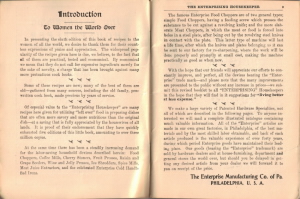 Here is a scan of the two pages, you can click it to view a larger image.
Here is a scan of the two pages, you can click it to view a larger image.
Introduction
To Women The World Over
(pages 2 and 3)
In presenting the sixth edition of this book of recipes to the women of all the world, we desire to thank them for their countless expressions of praise and appreciation. The widespread popularity of the recipes given here is due, we believe, to the fact that all of them are practical, tested and economical. By economical we mean that they do not call for expensive ingredients merely for the sake of novelty, a charge that has been brought against many more pretentious cook books.
Some of these recipes are new; many of the best of them are old–gathered from many sources, including the old family, pen-written cook book, made precious by years of service.
Of especial value to the “Enterprising Housekeeper” are many recipes here given for utilizing “left over” food in preparing dishes that are often more savory and more nutritious than the original dish–at a saving that is fully appreciated by the housewives of all lands. It is proof of their endorsement that they have quickly exhausted five editions of this little book, amounting to over three million copies.
At the same time there has been a steadily increasing demand for the labor-saving household devices described herein: Food Choppers, Coffee Mills, Cherry Stoners, Fruit Presses, Raisin and Grape Seeders, Wine and Jelly Presses, Ice Shredders, Spice Mills, Meat Juice Extractors, and the celebrated Enterprise Cold Handle Sad Irons.
The famous Enterprise Food Choppers are of two general types; simple Food Choppers, having a feeding screw which presses the substance to be cut against a revolving knife; and the more elaborate Meat Choppers, in which the meat or food is forced into holes in a steel plate, after being cut by the revolving steel knives in contact with the plate. This latter type of machine will last a life time, after which the knives and plates belonging to it can be sent to our factory for re-sharpening, where the work will be done properly and promptly at small cost, making the machine practically as good as when new.
With the hope that our friends will appreciate our efforts to constantly improve, and perfect, all the devices bearing the “Enterprise” trade mark–and please note that the many improvements are presented to the public without any increase in prices–we submit this revised booklet to all “ENTERPRISING” Housekeepers in the hope that they will find in it suggestions for “living better at less expense.”
We make a large variety of Patented Hardware Specialties, not all of which are described in the following pages. To anyone interested we will mail a complete illustrated catalog containing much valuable information. All of the “Enterprise” articles are made in our own great factories, in Philadelphia, of the best materials and by the most skilled labor obtainable, and back of each article produced is the valuable experience of over forty years, during which period Enterprise goods have maintained their leading place. Our goods (bearing the “Enterprise” trademark) are sold by hardware dealers and at house-furnishing, department and general stores the world over, but should you be delayed in getting any desired article from your dealer we will forward it to you on receipt of the price.
The Enterprise Manufacturing Co. of Pa.
PHILADELPHIA, U.S.A.
Here’s a recipe for dip that is served with a corn bread bowl (cut out inside, pour in the dip then serve). Hard to say how old this recipe is but I’d guess 1970s or 1980s. Found in a box of assorted recipes.
Corn Bread Dip
1 lb loaf corn bread
1 1/3 c. sour cream
1 1/3 c. mayonnaise (*corrected spelling)
2 T dried minced onion
2 T parsley flakes
2 T dill weed
2 T celery salt
Mix all ingredients. Cut inside out of bread to form a bowl for dip; cut up inside for dipping.

